Japan always felt like a place that could depend on the steady influx of Chinese travelers—tour groups with coordinated flags winding through Asakusa, suitcases rolling across Ginza’s polished sidewalks, and duty-free shopping bags stacked in airports like trophies of a weekend spree. For years, this flow wasn’t just tourism—it was a structural economic pillar. Then tensions escalated, travel advisories went out, cancellations piled up, and suddenly a market many assumed was permanent revealed how fragile global demand can be.

Now Japan finds itself in a moment of forced adaptation. The shift happened quickly: stock prices of tourism-exposed companies stumbled, hotel occupancy forecasts changed tone, and policymakers started talking about diversification rather than reliance. The abrupt slowdown in Chinese arrivals exposed a hard truth—Japan’s tourism boom was overly concentrated. While Chinese visitors represented roughly a quarter of inbound travelers, they accounted for more than a third of total tourism spending, particularly in premium retail, cosmetics, pharmaceuticals, and high-margin hospitality. Losing that segment isn’t just a dip in headcount; it changes the financial model of tourism itself.
But Japan isn’t just sitting still. One of the most interesting developments is the emerging pivot toward Southeast Asia, India, South Korea, and Western long-haul travel markets. Airlines are rebalancing schedules. Tourism boards are translating campaigns into Thai, Vietnamese, and Bahasa Indonesian rather than relying on Mandarin-first messaging. Even shopping districts—once entirely geared toward Chinese consumption patterns—are experimenting with multilingual digital payment options, varied product lines, and marketing that focuses less on “luxury quantity buying” and more on “experience-based travel.”
Domestic tourism is also quietly stepping back into the spotlight. After COVID, Japanese citizens rediscovered their own country: regional trains filled up, ryokan stays surged, and small towns enjoyed spending that once flowed only through Tokyo, Osaka, or Kyoto. That momentum never entirely disappeared, and now it’s being nurtured again—not as a stopgap but as a stabilizer. Local governments are offering travel vouchers, prefectures are revamping heritage sites, and the narrative is shifting from mass tourism to cultural depth, slower travel, and seasonality beyond cherry blossoms and autumn leaves.
There’s also a subtle but important mindset change among investors and operators. The old tourism strategy treated inbound spending almost like a commodity economy: scale, volume, repeat. The new thinking leans closer to portfolio management—spread the risk, seek diverse markets, create differentiated value, and avoid overexposure to any single geopolitical channel. If Japan’s beauty brands, hospitality groups, luxury retailers, airlines, and tourism platforms once built around a single dominant audience, they are now recalibrating toward resilience.
Even the traveler experience is evolving. Japan is leaning harder into culinary tourism, outdoors and national park travel, anime and pop-culture itineraries, wellness destinations, and sustainable tourism trails that were once secondary projects. There’s a faint sense that this might ultimately be healthier for the industry—less dependent on group tours and more aligned with travelers who stay longer, explore deeper, and engage more meaningfully.
The situation isn’t without pain. Businesses optimized for Chinese group travel—duty-free corridors, volume retail, and high-turnover tour dining—will need structural change, not just marketing polish. Some will struggle. Others will reinvent. And Japan, with its tendency to quietly but decisively adapt rather than panic, seems already in motion.
The broader story is almost cyclical: a tourism superpower discovering that global mobility isn’t guaranteed and that geopolitics can reshape economies faster than any marketing campaign. Yet there’s also a sense of quiet confidence. Japan has the cultural gravity, the memories, the landscapes, the craftsmanship, and the mystique that travelers return to—even if the path back temporarily reroutes.
Leave a Reply